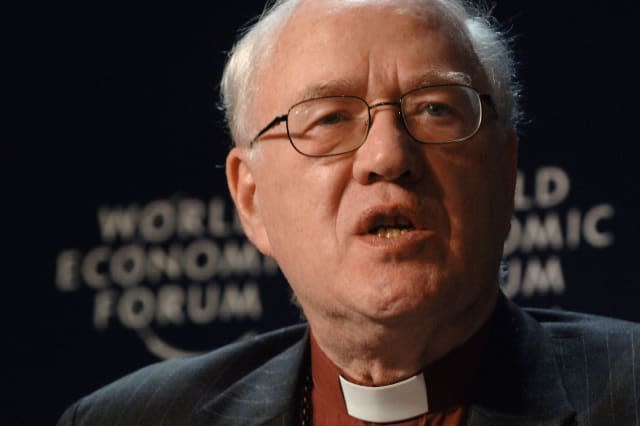University removes ex-Archbishop of Canterbury's image after student campaign
An image of former Archbishop of Canterbury, Lord Carey of Clifton, has been removed from a top London university amid student concerns about his views on gay marriage.
The picture is one of a number to be taken out of a "wall of fame" at King's College London (KCL), which said that the display "did not capture the diversity of our university community".
The removal of Lord Carey's image follows a campaign by a group of students at the institution, who had voiced concerns about opinions the church leader had expressed during the debate on gay marriage.

A spokesman said that a number of static portraits, including those of Lord Carey, Archbishop Desmond Tutu and Sir Michael Howard had been removed in order to make space for new digital screens next to a university entrance.
The move followed a review of KCL's window display policy, conducted last year.
Lord Carey said he did not wish to comment. The university has not commented on the student campaign.
Speaking in 2012, Lord Carey said that for "time immemorial", marriage had been between a man and a woman and gay relationships were not the same.
''Same-sex relationships are not the same as heterosexual relationships and should not be put on the same level," he said.
In a blog post, Ben Hunt, who had been involved in running the student campaign and is now president of KCL's student union, said: "LGBT+ students over several years had been concerned with the portrayal of Lord Carey of Clifton as an alumni who should be celebrated due to his views expressed during the debate regarding gay marriage.
"A petition was signed asking for his removal by hundreds of students several years ago, as well as policy being passed through our democratic system endorsing the Union to take this stance."
Mr Hunt went on to write that he worked with the university on the new digital display, and that the windows "express a community which strives to be accepting of diversity and inclusive".
He added: "It comes after a campaign of several years which was concluded through collaboration and a shared will of the Union and College to do more to represent what all of the King's community does in service of society."
A KCL spokesman said: "In 2015 a review of our window display policy across all our campuses was undertaken by representatives from External Relations, the Students' Union and Alumni Relations.
"It was agreed that the current static displays, which are costly to maintain, or change, did not capture the diversity of our university community and that this should change.
"The decision was taken that we should expand the breadth of content to include the achievements of our students and staff.
"The first digital screens, launched in July 2016, now bring to life examples of research breakthroughs and student and staff successes, as well as the contribution of our renowned alumni.
"In order to make space for the screens next to the prominent Strand campus entrance, a number of static portraits, including those of Lord Carey, Archbishop Desmond Tutu and Sir Michael Howard, were removed.
"The individuals were notified in advance and expressed themselves fully supportive. Further digital screens will be rolled out when we move into Bush House in September 2017."
It is not the first time that students have campaigned for the removal of objects and statues from campuses.
Earlier this year, a number of students led a campaign calling for Oriel College at Oxford University to take down a statue of British colonialist Cecil Rhodes.
And Jesus College at Cambridge University removed an African bronze cockerel from display after a campaign by students. The College said that the Benin bronze Okukor had been taken down from its hall and it would hold discussions about its future ''including the question of repatriation''.


